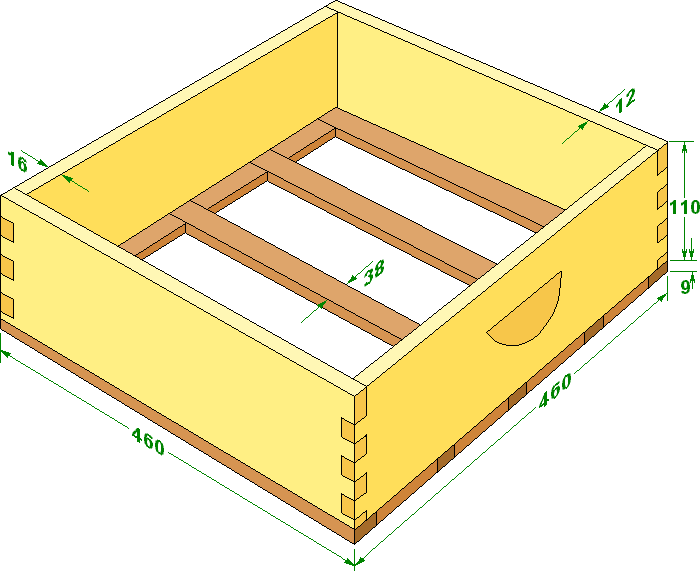Commercial Hive
Sections
|
|
|
|---|
|
Commercial Hive Sections |
Section Rack for the British National Bee Hive |
|---|
You may be confused by the terms "Section Rack" and "Section Crate". They are the same thing. This design is for a B.S. National or Commercial hive, but they are available for all hive designs.
Section honey was a big thing before extracted honey became popular. Many of the items that the antiques trade describe as 'butter dishes' were in fact containers for honey sections, that were placed on tables over a hundred years ago. There is still a market for high quality sections and those that recognise such quality will pay high prices to get the best.
This design of section rack is a wooden crate designed to enable thirty two wooden honey sections to be added to a National bee hive in order that the bees may fill them with comb honey. It follows the design of the original British Standard version, which has some flaws when used in areas of poor weather and low forage density.
Getting bees to fill sections with honey is an art that many years ago delineated experts from novices, but if you use the method outlined on the easy sections page, you can produce large numbers of well filled and nice looking sections.

The sections were designed in the days of imperial measurements and were 4 1/4" square with the breadth of the wood being 1 15/16". The modern metric equivalents being 108 mm x 50 mm.
Various patterns of bee ways were scalloped in the edges according to the fancy of the beekeepers in different regions of UK. These regional variations along with the number of sides having splits, giving rise to the names associated with each type... The 'English' style has scallops on all four sides and only one of the sides is split, whereas 'Irish' sections have three of the sides split.
The sections are arranged in eight rows of four and each end of each section rests on the bars that form the bottom of the rack, this leaves a space at one side of the stack and this space is filled with a 'follower board' of about 12 or 15 mm thickness that compresses the stack into close contact by means of a curved leaf spring. The spaces between the bars are filled at each edge with fillets of 9 mm thick timber so that the bees cannot escape or reach the void between the follower board and the side of the rack, but on the other side the fillets are the same width as the rack side. (This cannot be seen in the diagram)
Cutting List
| Qty | Length | Width | Thickness | Material | Usage |
|---|---|---|---|---|---|
| 2 | 460 | 110 | 16 | Softwood | side panel |
| 2 | 460 | 110 | 12 | Softwood | end panel |
| 5 | 460 | 38 | 9 | Softwood | support bar |
| 4 | 67.5 | 38 | 9 | Softwood | wide fillet |
| 4 | 67.5 | 16 | 9 | Softwood | narrow fillet |
| 1 | 435 | 110 | 12 | Softwood or ply | follower board |
I have seen versions that had support bars and wide fillets 35 mm wide with narrow fillet width and sides of thickness of 19 mm, and fillet length of 71.25 mm to match.
See also... The page on hanging section frames.
This National version is also used on B.S. Commercial hives... The small dimensional difference having no serious effect.
Originated... 17 May 2002, Upgraded... 02, 03 December 2005,
|